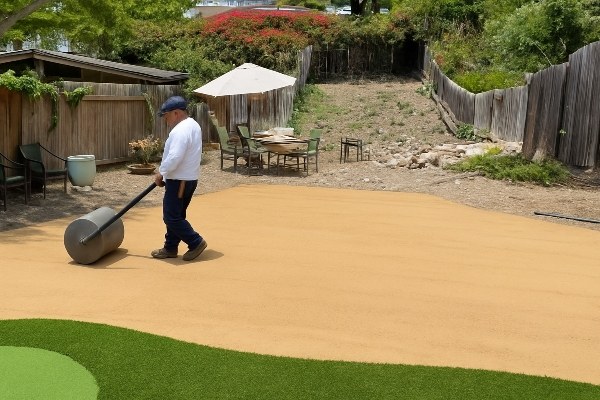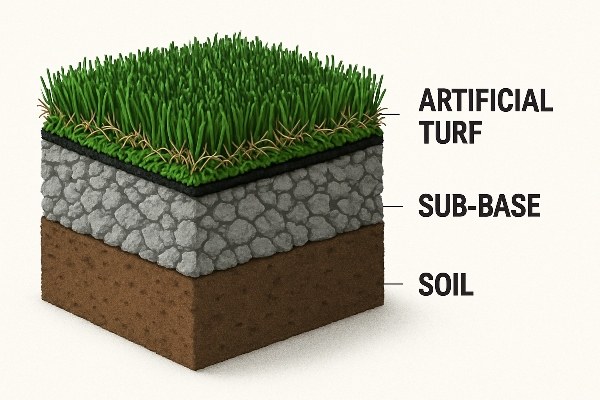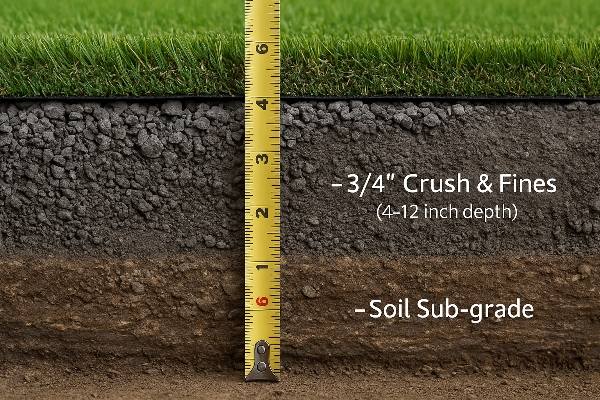Choosing the wrong base for your turf can ruin an entire project. This mistake leads to sinking, poor drainage, and costly repairs. Getting the foundation right is the first step.
The best base for artificial turf is a layer of compacted aggregate. Materials like Class II road base or decomposed granite are excellent choices. They provide the necessary stability and drainage that a professional, long-lasting installation requires.

A good installation starts from the ground up. In my years in this industry, I’ve seen beautiful, expensive turf fail simply because of what was underneath it. The base isn’t just filler; it’s the functional foundation of your entire system. It determines how the surface feels, how it drains, and how long it will last. Getting this part right saves you from major headaches and unhappy customers down the line. Let’s dig into the details to make sure your next project is a success from the very beginning.
Do I Need to Install an Artificial Grass Base?
Thinking of saving time and money by skipping the base? This can quickly turn your project into a disaster with wrinkles and puddles. A proper base is essential for a professional result.
Yes, you absolutely need to install a base. It is the most critical part of the installation process. A sub-base1 provides a stable, level surface, ensures proper drainage, and protects your investment by preventing the turf from sinking or developing problems later.

I get this question a lot, especially from clients trying to be competitive with their project bids. They see the base preparation as an area to cut costs. I always tell them the same story. I once had a client who insisted on laying turf directly over compacted soil for a small courtyard. Six months later, he called me in a panic. The ground had settled unevenly, creating low spots that turned into puddles every time it rained. Weeds were starting to push through the backing. The entire lawn looked lumpy and unprofessional. He had to pay for my team to pull up the turf, excavate the soil, and install the proper base we recommended in the first place. He paid twice for one job. The sub-base serves three critical functions that you cannot ignore.
The Role of Stability
Your artificial turf needs to be laid on a perfectly flat and stable surface. Native soil will shift and settle over time, which creates wrinkles and low spots in your turf. A compacted aggregate base creates a solid foundation that will not move, ensuring your turf looks smooth and perfect for years.
The Importance of Drainage
Water needs to drain through your turf and away from the surface. Soil, especially clay-heavy soil, does not drain well. This leads to standing water, which can cause mold, mildew, and a bad smell. A proper base made of crushed stone allows water to pass through easily and drain away, keeping your turf dry and clean.
The Key to Longevity
A proper base is the key to protecting your investment. It prevents damage from ground movement, ensures good drainage, and stops weeds from growing through. Skipping the base voids most manufacturers’ warranties and drastically shortens the life of your turf project.
What Are The Different Types of Artificial Grass Sub-Base?
You hear names like "decomposed granite2" or "crushed stone3" and it’s confusing. Choosing the wrong type for your climate or project will cause serious issues. Understanding the options is simple.
Common types include decomposed granite (DG), Class II road base4, and various sizes of crushed stone or gravel. The best choice depends on your project’s drainage needs, the desired firmness of the surface, and what materials are locally available and affordable.

Choosing the right material is a balance between performance, cost, and availability. In my experience working with customers globally, what’s cheap and common in one region might be expensive and hard to find in another. For example, decomposed granite is very popular in the western United States, but in other areas, a simple crushed limestone might be the standard. The key is to understand the properties of each material and match them to the demands of your specific project, whether it’s a soft lawn for a backyard or a firm, stable base for a sports field. Don’t just order what’s cheapest; ask your supplier about its compaction and drainage properties first.
| Material | Best For | Pros | Cons |
|---|---|---|---|
| Decomposed Granite (DG) | General landscaping, putting greens | Compacts very well, creates a firm surface | Fines can clog drainage in very wet climates |
| Class II Road Base | Sports fields, high-traffic areas | Excellent stability and drainage, very durable | Can be more expensive, sometimes overkill for small jobs |
| Crushed Stone/Gravel | Areas needing maximum drainage | Excellent drainage, readily available | Can be harder to level perfectly, may not compact as tightly |
I advise most of my customers doing sports field projects, like football or baseball fields, to use a Class II road base or a similar, engineered aggregate. It provides the stability and durability needed to withstand heavy use and ensures consistent playing performance. For a simple residential lawn, decomposed granite or a 3/4" crushed stone is usually more than enough.
How Much Sub-Base Is Required?
You are unsure how deep the base layer should be. Too little and the installation will fail. Too much and you are wasting money on materials and labor. There’s a rule of thumb to follow.
A standard installation needs a compacted sub-base of 3 to 4 inches (75-100mm). For high-traffic areas, sports fields, or places with poor soil, this depth should increase to 6 inches (150mm) or more to ensure long-term stability.

The "right" depth is one of the most important specifications in any project plan. It’s not just about digging a hole and filling it. The depth is measured after the material has been fully compacted with a plate compactor. I always remind my clients that a 4-inch layer of loose stone will compact down to about 3 inches, so you have to account for that. Underestimating the depth is a common shortcut that leads to failure. A base that is too thin will not provide enough stability, and the surface will show imperfections from the ground below. It’s better to add an extra inch than to be an inch too short.
For Residential Lawns
For a typical front yard or backyard with light foot traffic, a compacted depth of 3 inches is usually sufficient, as long as the native soil is stable. If you are dealing with heavy clay soil that holds a lot of water, I would increase this to 4 inches to improve drainage.
For Pet Areas and Playgrounds
In areas that will see a lot of activity, especially from pets or children, you need more stability. I recommend a minimum compacted depth of 4 inches. This helps dissipate energy from running and jumping and ensures the area can handle concentrated traffic without developing low spots. For playgrounds, this base is often installed below a shock pad for extra safety.
For Sports Fields
This is where you cannot cut corners. For football fields, baseball infields, or tennis courts, a compacted base of 4 to 6 inches is the industry standard. The base must be perfectly graded to ensure proper slope for drainage and provide a completely uniform surface for safe and consistent play. Anything less will compromise the performance and safety of the field.
Conclusion
A proper sub-base is not just a part of the project; it is the foundation for success. Choosing the right material and depth ensures a durable, professional result that will last for years.
-
Learn how a sub-base contributes to the longevity and stability of your artificial turf. ↩
-
Discover why decomposed granite is a popular choice for turf projects and its advantages. ↩
-
Learn about the excellent drainage properties of crushed stone and its suitability for turf. ↩
-
Find out how Class II road base provides stability for high-traffic areas and sports fields. ↩
_画板-1.png)
_画板-1.png)